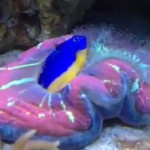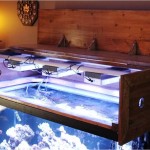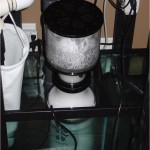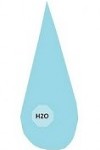Category Archives: Reef

Open brain corals capable of catching and consuming live healthy fish
You seldom think about corals catching and eating your otherwise healthy fish but it might be good to know that it does happen. You might want to avoid coral species such as Trachyphyllia and other large polyp stone corals in tanks where you keep fish you really care about. The risk of something like this happening is small but ever present.
The video below shows an open brain coral in the tank of Dmitry Tumanovthat has caught and is consuming an otherwise healthy, living, large azure damsel fish. Dimitry shot this video after having lost several fish that was no where to be found.
Via reefbuilders
Giant Marine Clams
Giant Clams
For many, many years out reach for marine aquarium keepers are the giant clams, Tridacna species. And to this day. though captive raised, giant clams are not for nascent keepers.
That said they can be kept if one has the intensity and quality of lighting, a steady temperature, and natural sea water levels of minerals, and sufficient alkalinity to buffer it.
The two most common reasons why giant clams fail in aquariums are insufficient light, and predation. In the former, clams contain a symbiotic algae species in their flesh. Like most all algae (other than cyanobacteria of course), the algae that give the vivid colors of giant clam flesh photosensitize light. The wastes from that photosynthesis are sugars that feed the clam. Also, giant clams need a brisk, chaotic flow, similar to that needed for Acropora species corals.

Reef Lighting
This article was written by myself and Cliff. The first part was written by me (Dave66), and Cliff gives an overview of LED (Light Emitting Diode) lighting.
—-
Perhaps the most important and vital piece of equipment one can buy for their reef aquarium is lighting.
Fully 95 percent of corals available in shops and online are photosynthetic. That is, they have photosynthetic bacteria in their tissues (zooxanthellae). The bacteria ‘feed’ on the light, and the sugars they produce as waste feeds the coral.
On the tropical reef it’s the sun that powers the photosynthesis of zooxanthellae. In the aquarium, it is the responsibility of the keeper to simulate the sun in their aquariums. Lighting is one of the major costs in starting a reef tank. Continue reading
Marine Reactors
Reactors
In marine aquariums, available are several types of reactors. Reactors are simply acrylic cylinders that contain some type of media. Internal construction varies, depending on the brand and type of reactor.
What follows are reactor types and their purpose.
—–
Perhaps the most valuable of the reactors in a reef aquarium is a Calcium Reactor.
Maintaining natural sea water levels of minerals and trace elements, and alkalinity of a sufficient level to buffer them, is a challenge for many new and not so new reef aquarium keepers.
A Calcium Reactor can negate that challenge. The reactor is loaded with an aragonite media or similar, which as it dissolves, continually maintains natural sea water levels of minerals and trace elements, and the optimal level of alkalinity. Having a Calcium Reactor is cost effective in the long run, since it will keep you from having to buy products for the marine minerals and trace elements, plus alkalinity, regularly.
Reef Filtration
Reef Filtration
Though in smaller reef aquariums, the organisms in live rock and sand process Nitrate, reducing it naturally to zero. In larger reefs, that is over 90 gallons in size, with more life in, filters can help in keeping it at zero
However, there are several types of filtration that can help keeping your water quality high.
Natural Nitrate Removal
Both fishes and corals produce waste, in fact, all the life in your marine reef does.
And that produces Nitrate. Like freshwater Nitrifying bacteria, their marine counterparts do the same thing; convert the Ammonia generated by fish urea into Nitrite, then Nitrate, which freshwater hobbyists dilute by regular partial water changes.
While mature live rock coupled with live sand can keep Nitrate quite low in smaller tanks with very few fishes, there are methods of eliminating it all together. Most test kits don’t have the resolution to detect low levels of Nitrate in marine tanks. But if one keeps reef fishes, believe me it’s there
First, Nitrate is an atom of Nitrogen and two of Oxygen. When those Oxygen atoms are removed, what you get is Nitrogen Gas, which all air-breathing life breaths (in fact, the the air we breath is 21 percent Oxygen, 70 percent Nitrogen).
There are two prevailing methods of naturally reducing Nitrate to zero constantly. They are deep sand beds and plenums.
What makes them work is the Nitrifying bacteria that exist in low Oxygen environments which are 2 ppm Oxygen down to .02 ppm.
What those bacteria do is take those two Oxygen atoms from the Nitrate for their own use, and the result is pure Nitrogen Gas.

Protein Skimmers
Protein Skimmers
One of the most desirable and in many cases indispensable pieces of marine equipment are Protein Skimmers.
Called foam fractioners among the science folk, skimmers have been available since the early days of the serious marine aquarium hobby.
Benefits of Protein Skimmers are many. First, their purpose is to remove dissolve organics from your tank water before they decay and cause your water quality to decline. Skimmers work by mixing air with the marine water, generating bubbles. The dissolved organics stick to the interface between the bubbles and the water. The bubbles burst at the top of the unit, and the organics fall into a collection cup there.
The skimmer cup fills with what is called the skimmate. The smell of the skimmate will bring great peace of mind that is out of your tank water. Many have to empty the skimmer cup daily, some more lightly stocked reefs every other day.
Emptying involves rinsing the cup out under a running tap, then replacing it on the unit. Also, one should clean the biofilm that forms inside the skimmer every few months, gaging the time based on the amount of biofilm, since it can hamper the skimmer’s filtering capabilities.

RO/DI units
When putting together this write-up, I used information that I researched / collected from: Perfect Life Water, Water Filters On-line, Rocky Mountain Discus on-line, Watts Canada, and Honeywell Canada along with my personal experience.
First a little history (to skip the history part if you are not interested, just click on “continue reading” below and scroll down to the first diagram)
The osmosis process was first discovered inthe 1700s by a French Scientist whom observed water diffusing spontaneously through a pig bladder. In nature, contaminant which dissolved into water normally exists in the form of ions (commonly referred to as salt). A pig bladder is lined with a membrane that has small enough pore sizes that will not allow the transfer of salt ions, but large enough to still allow the water molecules to pass through. This is used as a separation medium between water having two different concentration of salt. Water will generally transfer from the least concentration side to the higher contamination side as equal concentration will give equal pressure.